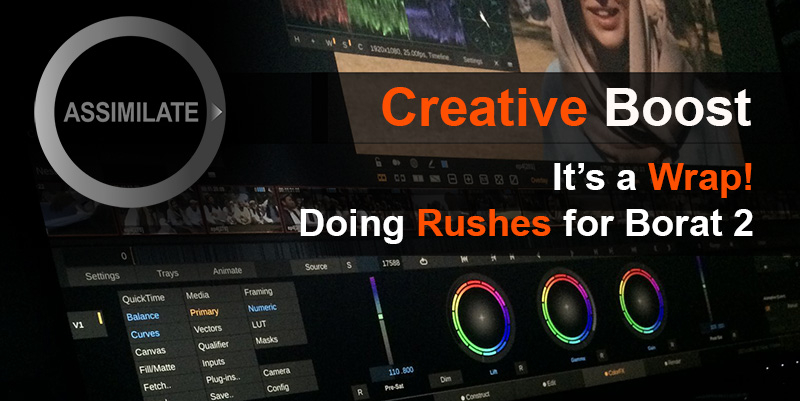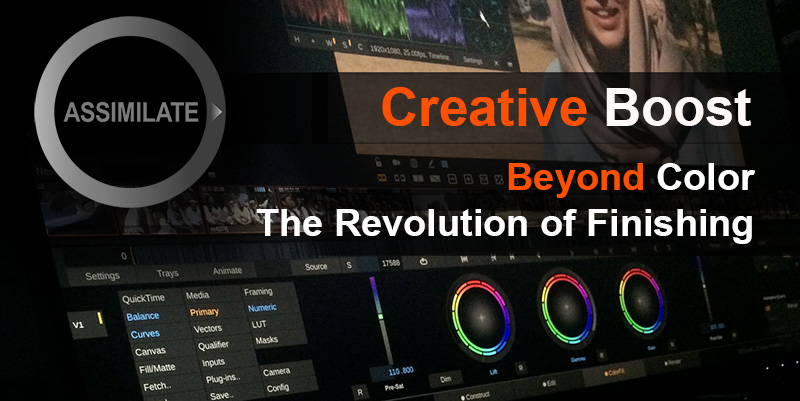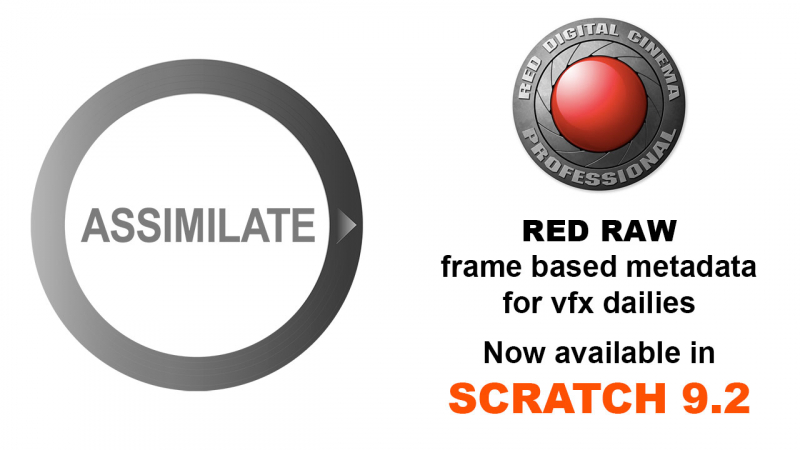-
Posts
255 -
Joined
-
Last visited
Content Type
Profiles
Case studies - Free
Case studies - Premium
Resources
Insider
Courses
Forums
Store
Posts posted by Mazze
-
-
Hey friends,
last week we released SCRATCH and Play Pro 9.3.
You can read the press release on the common news portals 🙂 .In a nutshell, we added native support for NDI, integrated a direct connection to Light Illusion's ColourSpace CMS,
and a few other niceties like a CIE Plot scope, enhanced panel mapping capabilities and media defaults in the project settings.Here's a video showing why NDI is awesome and how to use it - kudos to Jeff Sousa!
Full Release notes below 🙂Assimilate Dailies / Formats
- Media defaults. You can now set default decode / debayer settings per media type to speed up the loading of media.
- Update on ProRes RAW color spaces processing where for log spaces a normalized to reflection scaling has been added. This scaling factor has also been implemented for conversions from/to Canon Log 2 and Log3. Note that this affects existing setups.
- Added a Highlight Recovery option with DNG media format.
- CineForm RAW updates: added Exposure/Saturation, added Kelvin/Tint options which were not yet available with CPU debayer, highlight recovery with GPU debayer.
- Update R3D SDK 7.3.5 with various GPU decoder fixes.
- Native support for Panasonic Op1b MXF media, including audio.
- The FFmpeg reader now also processes multiple mono tracks of audio (rather than a single mono or stereo track).
- All QuickTime renders now include an explicit gamma metadata value (rather than a reference to a standard eotf, which is not interpreted the same by other software such as the QuickTime Player). In prior versions you had to explicitly enable this option in the advanced settings. In this version you can disable the behavior through the advanced settings.
- Added support for Network Device Interface (NDI) output. To enable NDI output you have to enable the (virtual) NDI device in the VideoIO settings, similar to enabling an SDI device.
- Rendering EXR could crash if the (EXR) source and destination were both ACES.
Color
- Added a project setting to set the default state of the colorspace Apply mode in a project. This Color Management setting is switched off by default.
- Added a CIE plot display with the scopes
- You can now associate a panel-group with a specific ColorFX menu. The application switches automatically to the menu if a panel mapping in the group is used.
- Added a system setting to include layers with a qualifier in the creation of a LUT. By default grades on a qualifier layers are not included in a LUT as they span only part of an image.
Misc
- Added an advanced system setting to specify a specific Frame Heap memory size used by the application for its image cache.
- Added new render date metadata code '#rdate' for filename mask. The date is fixed at the start of the render and does not change when the render runs into the next day (like the #date code does).
- New user settings to toggle on/off the quick keys for adding/removing/resetting keyframes to avoid unintentional adjustments of keyframes.
- When a layer was selected you could not change the source LUT (which is tied to the primary layer).
- The Note editor did not always insert a new note on the correct position. Also, the note markers on the timeline in the player now show all colors of notes at the same frame position.
- Fixed an issue where effects (like re-timer) where applied in a reverse assembling.
- The Validate Media was not always working correctly for items in the Render Queue.
- Added a user preference setting to enable/disable using the spacebar for start/stop playback. Some users want to use the spacebar exclusively for panning the image in the Viewport.
- Added the Ligth Illusion plug-in for generating color patches which are used for calibrating a monitor / projector. The plug-in can be instantiated from the Tools menu / default Construct menu in Play Pro.
Cheers,
Mazze-
 1
1
-
Hey People!
Recording of the online session is up - we've had a blast 🙂 .
Lisa walked us through the challenges of shooting the second Borat movie, and right after Jeff Sousa of Dungeon Beach, NY showed one of the main new features in SCRATCH and Play Pro 9.3: Native NDI support and how you can use it to easily connect to SetStream.io, or even Zoom and Skype. Also featured in his setup: Nobe OmniScope, running on his main workstation alongside SCRATCH, using an iPad via Duet Display.
Enjoy the recording, folks:
Cheers,
Mazze
-

Online Session hosted by Mazze Aderhold
Tuesday, November 3rd
10am Los Angeles | 1pm New York | 7pm BerlinRegister here: https://www.assimilateinc.com/join-webinar/
What is this online event about?
Our Creative Boost Program is coming to an end – that calls for a wrap party!
And with that, many people are wondering how things will continue.
Well – tune in and be first to know 😉 .
Special guest for this online meet-up is Lisa Konecny of ((RADAR)) DIT.
For over 12 months she was secretly working on the second Borat movie with Sacha Baron Cohen,
providing rushes and clip reports for post – having SCRATCH as her wingman.
Lisa will go over the challenges of a highly unusual shoot with over 73 cameras, no slates for audio syncing
and an unpredictable production schedule – with some incredible stories to tell!If you have something great to share about a project you did on SCRATCH – feel free to reach out and become an active part of our wrap party!
The event is free for all attendees.
The content is designed for DITs, data wranglers, colorists and finishing artists.
We will also record the event for you to watch later.
Please send your questions, comments and feedback to: info@assimilateinc.comCheers,
Mazze -
Hi everyone,
In this online session, Leandro Marini of Imperial Creative will go over the problems of modern DI-workflows and how to solve them by minimizing the back and forth with clients utilizing SCRATCH’s biggest strengths: Realtime color & comp, remote & live streaming and integration of other tools right into the workflow. Leandro will show a recent project, on which he approached color and vfx finishing simultaneously in realtime via remote, from concept art through the finished sequence.
This webinar will not be SCRATCH-only – Leandro will also show how to integrate
After Effects efficiently into the workflow to support SCRATCH in advanced vfx workflows, bringing the strength of both tools together into the finished film.Cheers,
Mazze -
And the recording is online, friends:
Cheers,
Mazze -
Hi friends,
here's a quick video on how to set up Nobe OmniScope with SCRATCH (and all other Assimilate products)
and also a quick overview of its features and how to use it 🙂 .Also, you can get 15% OFF by using coupon code SCRATCHOSCOPE at the checkout over at www.timeinpixels.com!
Cheers,
Mazze-
 1
1
-
-
Hi peoples,
I've written a little article on refurbishing Element panels by either foiling them, lacquering them,
or sandblasting and anodizing them.If you have questions, or want me to do it for you, feel free to reach out:
https://www.angry-face.com/refurbish-tangent-element/Cheers,
Mazze -

Online Session hosted by Mazze Aderhold
Wednesday, September 16th
10am Los Angeles | 1pm New York | 7pm BerlinRegister here: https://www.assimilateinc.com/join-webinar/
What is this online event about?
In this online session, Leandro Marini of Imperial Creative will go over the problems of modern DI-workflows and how to solve them by minimizing the back and forth with clients utilizing SCRATCH’s biggest strengths: Realtime color & comp, remote & live streaming and integration of other tools right into the workflow. Leandro will show a recent project, on which he approached color and vfx finishing simultaneously in realtime via remote, from concept art through the finished sequence.
This webinar will not be SCRATCH-only – Leandro will also show how to integrate
After Effects efficiently into the workflow to support SCRATCH in advanced vfx workflows, bringing the strength of both tools together into the finished film.The event is free for all attendees.
The content is designed for colorists and finishing artists.
We will also record the event for you to watch later.
Please send your questions, comments and feedback to: info@assimilateinc.comSee you all there, folks!
Best,
Mazze-
 1
1
-
-
Such nice rings you got there on your Element 😜 .
-
 2
2
-
-
Hi everyone,
in this tutorial we're going over how to create an advanced key in SCRATCH,
using multiple qualifiers, layers and blendmodes.
Also we'll show how to use and navigate the node tree in SCRATCH.
Enjoy 🙂 .Cheers,
Mazze-
 1
1
-
-
Hi folks,
this is a quick run-through for those, that are particularly interested in creating dailies, or new online masters
from ProRes RAW material. As an added bonus, I appended the intro video about white balance controls below 😉 .Cheers,
Mazze -
Hi everyone,
in this online session we will show you how to use Assimilate Live Assist to boost your on-set workflow and adapt to an era of social distancing and fewer bodies on the set. Whether it’s live grading, live green screen replacement, multi-cam recording & playback or using Live Assist as a Media-hub to live-stream out multiple camera feeds, or instant-review footage and grades from any phone, tablet or laptop near-set. We will also have Stefan King from Difference Live Streaming, showing us the latest developments of their private low-latency streaming platform, and how to use it with Live Assist.
Live Assist On-Set Workflow:
• Example setup with 2 cameras
• Live grading both camera feeds
• Live effects & green screen replacement
• (auto-) recording and playback of camera feeds
• Set up Multi-Cam Live Stream from Live Assist
• Use of on-screen annotations to communicate with remote clients
• Thatcher Kelley from SetStream.io showing how to stream to a secure private platform
• Built-in http web interface for local on-set instant review of recorded clips and grades
• Generating reports and grade index for post houses
• Post Workflow for dailies
• Short- and Mid-term plans for Live Assist
• Q&ACheers,
Mazze -
Hi everyone,
This online session does not only highlight why you want to do dailies in SCRATCH, but also show you how to do it. Mazze walks you through the complete dailies process – from import to export, incl. all the advantages that come with it. You’ll walk out of this online session, fully prepared to start a dailies job on SCRATCH. Also we will have Ansgar from the COPRA team to show the latest features for v5 their web dailies platform!
Dailies in SCRATCH:
• settings & project creation
• importing clips
• offloading
• import of ALE/EDL
• Media Browser Tool
• LUT/CDL loading & matching
• audio sync (TC-based + manual sync) incl. LTC
• metadata QC + Scene/Take
• dailies grading + RAW decode options
• color management (i.e. monitor HDR and SDR side by side)
• timeline automation
• output tree with different deliverables and metadata burn-ins
• output filenaming + preset creation
• render check / QC reports
• import offline clips into Avid, incl. all clip metadata
• COPRA Dailies Platform - new Version Demo
• Q&ACheers,
Mazze -
Yes people - it just went up online 🙂 .
Here you go:
Cheers,
Mazze-
 1
1
-
-
Slight update here: We will have Thatcher Kelley from www.setstream.io with us tomorrow, showing multi-cam live streaming through this new platform. It's gonna be pretty awesome 🙂 .
-

Online Session hosted by Mazze Aderhold
Wednesday, July 8th
10am Los Angeles | 1pm New York | 7pm BerlinRegister here: https://www.assimilateinc.com/join-webinar/
What is this online event about?
In this online session we will show you how to use Assimilate Live Assist to boost your on-set workflow and adapt to an era of social distancing and fewer bodies on the set. Whether it’s live grading, live green screen replacement, multi-cam recording & playback or using Live Assist as a Media-hub to live-stream out multiple camera feeds, or instant-review footage and grades from any phone, tablet or laptop near-set. We will also have Stefan King from Difference Live Streaming, showing us the latest developments of their private low-latency streaming platform, and how to use it with Live Assist.
Live Assist On-Set Workflow:
• Example setup with 2 cameras
• Live grading both camera feeds
• Live effects & green screen replacement
• (auto-) recording and playback of camera feeds
• Set up Multi-Cam Live Stream from Live Assist
• Use of on-screen annotations to communicate with remote clients
• Thatcher Kelley from SetStream.io showing how to stream to a secure private platform
• Built-in http web interface for local on-set instant review of recorded clips and grades
• Generating reports and grade index for post houses
• Post Workflow for dailies
• Short- and Mid-term plans for Live Assist
• Q&AThe event is free for all attendees.
The content is designed for DITs and Video Assists.
We will also record the event for you to watch later.
Please send your questions, comments and feedback to: info@assimilateinc.com-
 1
1
-
-
Don't believe so.
-
Hi all,
since metadata is more important than ever before in nowadays vfx-heavy workflows,
frame based metadata is also being requested more often by vfx companies.With the latest SCRATCH build from yesterday we added support for frame based metadata from RED RAW footage.
This way, you can get frame based lens information (and other metadata) rendered into OpenEXR sequences.VFX-departments can use that information to link to and control the virtual camera inside their compositing software.
It's a huge timesaver and enables more accurate vfx work.If you wanna play around with it, get yourself a free license from our webpage:
https://register.assimilateinc.com/registration.aspxRelease notes are to be found here:
http://www.assimilatesupport.com/akb/Download51030.aspxCheers!
Mazze -
H264 does support 10 bit (in normal MP4s, but also in MXF - XAVC, XF-AVC and AVC-I are basically 10 bit H264 flavors).
However, not all players can decode it. Also not sure whether Resolve allows to render 10 bit h264.
In any case - as Stef mentioned, it might be a moot point anyways, since Youtube will convert it back to 8 bit.
-
You can, but in 99% Youtube will convert it to an 8 bit h264 again and stream that, instead of your 10 bit source.
Mainly because browsers to my knowledge are not able to decode 10 bit h264.
Next, most monitors that Youtube is being watched on are 8 bit panels anyways.
However, many of them have good dithering functionality, taking care of any banding.
Given that, you can just export as 8 bit right from the start.-
 1
1
-
-
Hi all,
here is a video that shows how to set up ScopeBox with Assimilate SCRATCH, Live Looks, Live Assist and Play Pro
for advanced video measuring:
Cheers,
Mazze-
 1
1
-
-
And here is finally the recording of the session.
It is 2 hours long, but after those you'll be able to drive your dailies in SCRATCH 😉 .
-
Hi everyone,
as RED recently released their new metal-decode SDK, I found it a good idea to make a quick video
about which settings you can tweak in order to maximize performance for playback and transcoding.
Cheers,
Mazze -
Hi all,
here's the recording of our recent webinar about live streaming with an introduction to
the basics about live streaming as such and then setting up a live streaming session via Youtube,
or a custom streaming server - enjoy!
Greetz,
Mazze-
 1
1
-








Creative Reboot: Assimilate SCRATCH for less until the end of the month
in Announcements
Hey everyone,
if you are looking to get Assimilate SCRATCH, it's much discounted until the end of the year (about 30% off).
If you are a Lowepost member, you can apply your Lowepost discount code on top of that and save even more.
==> https://store2.assimilateinc.com/product/scratch/
Cheers,
Mazze